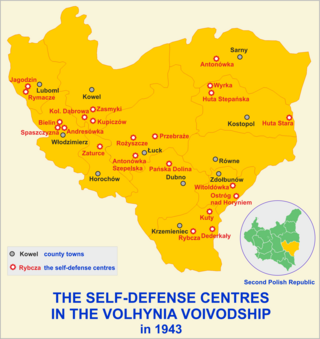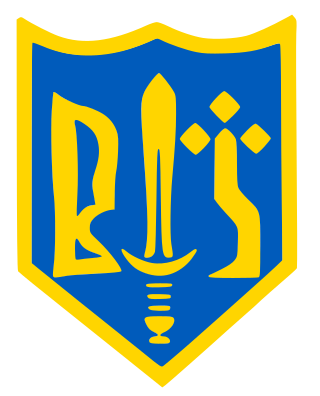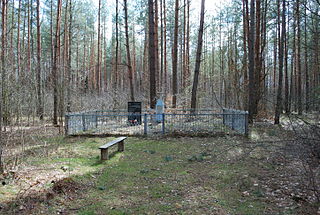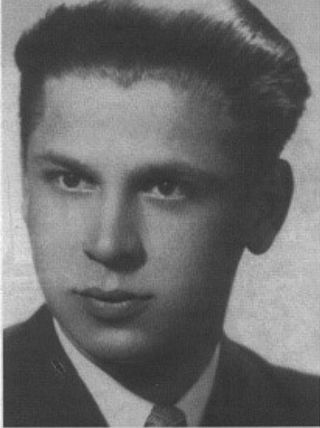
The Massacres of Poles in Volhynia and Eastern Galicia were carried out in German-occupied Poland by the Ukrainian Insurgent Army (UPA), with the support of parts of the local Ukrainian population, against the Polish minority in Volhynia, Eastern Galicia, parts of Polesia, and the Lublin region from 1943 to 1945.

The Ukrainian Insurgent Army was a Ukrainian nationalist paramilitary and partisan formation founded by the Organization of Ukrainian Nationalists on 14 October 1942. During World War II, it was engaged in Nazi collaborationism. However, the UPA later launched guerrilla warfare against Nazi Germany, the Soviet Union, and both the Polish Underground State and Polish Communists. It conducted the massacres of Poles in Volhynia and Eastern Galicia, which are recognized by Poland as a genocide.

The Ukrainian Supreme Liberation Council was a secretive legislature and de facto provisional government in areas under the control of the Ukrainian Insurgent Army (UPA) during and shortly after World War II. Including members of various political parties, the Ukrainian Greek Catholic Church and the UPA itself, the UHVR served to convince both Ukrainians and the international community was a serious group concerned with consensus-building and the establishment of an independent state.

The Defence of Przebraże was fought between the Ukrainian Insurgent Army against the Polish Self–Defense, Home Army and Soviet partisans in the Łuck County of the Wołyń Voivodeship. The Northern Operational Group under the command of Dmytro Klyachkivsky and 3rd Operational Group "Turiv" under the command of Yuriy Stelmaschuk tried four times to destroy and conquer the largest Polish Self–Defense base and center in the Volhynia, but the UPA didn't succeed.

Ukrainian People's Revolutionary Army, also known as the Polissian Sich or the Ukrainian Insurgent Army, was a paramilitary formation of Ukrainian nationalists, nominally proclaimed in Olevsk region in December 1941 by Taras Bulba-Borovets, by renaming an existing military unit known from July 1941 as the UPA-Polissian Sich. It was a warlord-type military formation without a strict central command. From spring 1942 until the autumn of 1943, it acted against the German rural civil administration and warehouses, from spring 1943 it also fought against Soviet Partisans and some units against Poles; from July–August 1943, it clashed with OUN-B Bandera's UPA and UB units.
Sluzhba Bezpeky or SB OUN, was the Ukrainian partisan underground intelligence service, and a division of the Organization of Ukrainian Nationalists responsible for clandestine operations and anti-espionage during World War II. In its short history, the SB committed acts of terror against civilians and non-civilians and their families, including people suspected either of collaborating, or serving with the Soviet forces in western Ukraine. In this capacity, the SB also played a significant role in the ethnic cleansing and killing of the Polish population in Volhynia and Galicia.
This article presents the historiography of the massacres of Poles in Volhynia and Eastern Galicia, as presented by historians in Poland and Ukraine after World War II.

Bortnytsia is a village in Rivne oblast, near the town of Dubno, in Dubno Raion, Ukraine. The village currently has a population of 365.

Stara Huta is a village in northwestern Ukraine, in Kovel Raion of Volyn Oblast, but was formerly administered within Stara Vyzhivka Raion. The population of the village is 1024 people.

The Parośla I massacre was committed during World War II by the Ukrainian Insurgent Army (UPA) under the command of Hryhorij Perehijniak "Dowbeszka-Korobka" on 9 February 1943 against the ethnic Polish residents of the village of Parośla in the Nazi-controlled Reichskommissariat Ukraine. It is considered a prelude to the ethnic cleansing of Poles in the Volhynia region by the UPA, and is recognized as the first mass murder committed by the Ukrainian Insurgent Army in the area. Estimates of the number of victims range from 149 to 173.

Huta is a village in Rivne Raion, Rivne Oblast, Ukraine, but was formerly administered within Kostopil Raion. As of the year 2001, the community had 744 residents. Postal code — 35010. KOATUU code — 5623481201.
The Litopys UPA volume series was created under the auspices of the Litopys UPA Publishing Company, an Ontario Corporation Without Share Capital incorporated in 1978. Publishing primary source, archival material and documents, and first person accounts that relate to the military history of the Ukrainian Insurgent Army UPA, underground resistance organizations, as well as the history of Ukraine during World War II and post-war decade. Each volume or group of volumes is devoted to a specific theme. Some deal with the military history in a specific period of time or region - for example, in Volyn, in Halychyna, as in the regions of Ukraine under Poland and so on. Two, three, or more volumes may be devoted to specicific themes. Memoirs, or books by individual authors dealing with particular questions, offer insight into individual topics. Ukrainian language with English introductions.
Hurby massacre was a mass murder of the Polish population of the Hurby village, perpetrated on June 2, 1943, by a death squad of the Ukrainian Insurgent Army (UPA) and so-called brushwood self defence commando made up of Ukrainian peasants, during the province-wide Massacres of Poles in Volhynia and Eastern Galicia in World War II. Hurby belonged to the Second Polish Republic before the war began. It used to be located in the powiat Zdobłunowski of the Wołyń Voivodeship. It is now a valley by the same name in western Ukraine. About 250 Poles were murdered in the attack, which was confirmed by the UPA commander for Volyn, Dmytro Klyachkivsky, who said in his communique of June 1943 that Hurby "went up in smoke".

Głęboczyca massacre was a mass murder of ethnic Poles carried out on 29 August 1943 by the troops of the Ukrainian Insurgent Army aided by the Ukrainian peasants. It exclusively targeted Polish inhabitants of the Głęboczyca colony, located in the Włodzimierz County of the Wołyń Voivodeship in the Second Polish Republic. About 250 Poles were killed, including 199 known by name including women and children. Głęboczyce does not exist anymore. It was swept from existence during the Massacres of Poles in Volhynia and Eastern Galicia, along with the neighbouring settlement of Ostrówek in powiat Luboml.
Zagaje massacre was a mass murder of ethnic Poles carried out on 11–12 July 1943 by the troops of the Ukrainian Insurgent Army group "Piwnicz", aided by the Ukrainian peasants, during the Massacres of Poles in Volhynia and Eastern Galicia. Approximately 260–350 people were killed, including women and children. The village Zagaje was levelled out and does not exist anymore. It was located in the gmina Podberezie of the Horochów County in the Wołyń Voivodeship of the Second Polish Republic. Overall, in the Horochów County some 4,200 ethnic Poles were murdered, in nearly hundreds of separate locations before the end of the Polish-Ukrainian conflict. The village Zagaje is not to be confused with the Zagaje colony, located in gmina Czaruków, powiat Łuck, of the same voivodeship.

The anti-Soviet resistance by the Ukrainian Insurgent Army was a guerrilla war waged by Ukrainian nationalist partisan formations against the Soviet Union in the western regions of the Ukrainian SSR and southwestern regions of the Byelorussian SSR, during and after World War II. With the Red Army forces successful counteroffensive against the Nazi Germany and their invasion into western Ukraine in July 1944, UPA resisted the Red Army's advancement with full-scale guerrilla war, holding up 200,000 Soviet soldiers, particularly in the countryside, and was supplying intelligence to the Nazi Sicherheitsdienst (SD) security service.

Self-defense Kushch Units (SKU) — Ukrainian self-defense units formed to protect Ukrainian villages, as well as to create a rear for the UPA. They operated in 1942–1946 and were inspected by the district leaders of the separate formation of OUN – OUN(b).
The Northern Operational Group of the Ukrainian Insurgent Army, also known as UPA-North, was one of the three operational groups of the Ukrainian Insurgent Army. It operated in Volhynia, Zhytomyr Oblast, Kyiv Oblast, and in the southern Byelorussian Soviet Socialist Republic.

Petro Mykolaiovych Fedun, also known by the literary pseudonym of Petro Poltava, was a Ukrainian revolutionary writer, journalist, and politician. Ideologically a Ukrainian nationalist and social democrat, he was one of the leaders of the reformist faction of the Organisation of Ukrainian Nationalists' Banderite wing from 1945 until his 1951 death in battle against officers of the Soviet Ministry of State Security.
The People's Revolutionary Liberation Organisation was the name adopted by a group of left-wing members of the Ukrainian Insurgent Army (UPA) who were briefly active in Volhynia in 1944. It was led by Vasyl Kuk, leader of the UPA's Southern Operational Group, and included several high-ranking members of the Southern Operational Group, such as colonel Petro Oliinyk.












